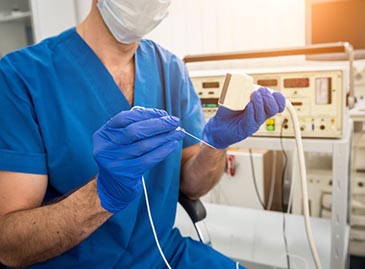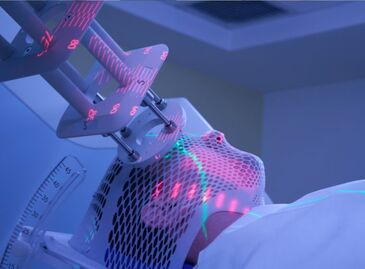
Laparoscopic Pelvic Lymph Node Dissection: Procedure
A laparoscopic pelvic lymph node dissection helps treat cancer. The surgeon makes a small incision in the lower abdomen to reach the lymph nodes. The surgeon inserts a tiny tube with a light and a camera (i.e., a laparoscope) into the incision and directs it to the lymph nodes.
About lymph nodes
The lymph nodes are part of the lymphatic system. The lymphatic system helps fight infections. It comprises lymph vessels, lymph fluid, lymph nodes, bone marrow, and lymphatic organs (thymus, adenoid, tonsil, and spleen).
Lymph vessels are skinny tubes similar to blood vessels. They collect and move lymph fluid away from tissues into the lymph nodes. Lymph nodes are small bean-shaped organs of lymphatic tissue. The lymph fluid can carry cancer cells from where the cancer started into the lymph nodes.
Lymph nodes and cancer
Lymph fluid from organs in the pelvis drains into the pelvic lymph nodes. The lymph fluid can carry cancer cells from these sites into the pelvic lymph nodes. Bladder and prostate cancers most commonly spread to the lymph nodes in the pelvis. Cancer may also apply to the pelvic lymph nodes from the following organs and tissues:
- Seminal vesicles (the glands on either side of the prostate that produce semen)
- Urethra (the tube that carries urine from the bladder to the outside of the body)
- Ovaries, uterus (womb), cervix, and vagina
- Testicles
- Penis
- Rectum
- Anus
- Perineum (the area between the anus and scrotum in men or the anus and vagina in women)
- Inguinal lymph nodes (lymph nodes in the groin)
- Lower abdominal wall
How pelvic lymph node dissection works
During a laparoscopic lymphadenectomy, the surgeon makes a small incision in the lower abdomen to reach the lymph nodes. A tiny tube with a light and a camera (i.e., a laparoscope) is inserted into the incision and directed to the lymph nodes.
The doctor navigates and inspects the region on a TV-like monitor that receives images from the camera and can biopsy or remove the lymph nodes with a cutting instrument and tissue retrieval apparatus that is also part of the laparoscope.
Laparoscopic lymphadenectomy can provide results equivalent to surgical biopsies or lymph node removal. Although it is carried out under general anesthesia, it is less invasive than surgery. So, your hospital stay will be shorter, and you will recover faster and with less pain.
In addition, the laparoscope images are magnified when they appear on the monitor, allowing your doctor to see even greater tissue detail than would be available during traditional surgery.
How pelvic lymph node dissection helps
A pelvic lymph node dissection is done to:
- Check for cancer in the lymph nodes in the pelvis
- Please find out how many lymph nodes contain cancer, how much cancer has spread to them, and the size of the lymph nodes
- Remove lymph nodes that contain cancer
- Remove lymph nodes when there is a high chance that cancer will apply to them
- Reduce the chance that cancer will come back (recur)
- Remove cancer that is still in the lymph nodes after radiation therapy or chemotherapy
- Help doctors plan further treatment
Procedure
A pelvic lymph node dissection (PLND) is a surgery performed under general anesthesia. A PLND may be done using a wide cut (open method) or laparoscopy (laparoscopic technique). The surgeon cuts (incision) in the abdomen and removes the pelvic lymph nodes. The lymph nodes and any other tissue removed during surgery are sent to a lab to be examined by a doctor specializing in the disease's causes and nature (a pathologist). After removing the lymph nodes, the surgeon places a small tube (drain) and closes the cut with stitches or staples. A drainage bag is attached to the end of the tube to collect fluid draining from the area. This reduces the chance of fluid building up in the tissue and improves healing. The drain is left in place for a few weeks or until there is little or no drainage.
Laparoscopic procedure
Your surgeon does the operation through minor cuts (keyholes) in your abdomen. They will use tools with a tiny camera attached so they can see the inside of your body on a screen.
In some hospitals, a robot will assist the surgeon. The surgeon is in the same room but sits away from you and controls the robotic arms to perform the surgery. It allows the surgeon to make more controlled and precise movements. The surgeon is still the one doing the surgery. This is sometimes called robotic surgery.
Recovery after keyhole surgery is usually faster because there is less blood loss. This means your hospital stay may be shorter.
Post-laparoscopic lymph node dissection
People who have a PLND are usually sent home 3–7 days after surgery. You may be given:
- Antibiotics to prevent infection
- Pain-relieving medicine
- Instructions on caring for and dressing the wound
- Information about how to manage the drainage bag and tube
- Advice on how much and which types of activity you can do after surgery
- A follow-up appointment to see the surgeon in 1–2 weeks
- Information about symptoms and side effects you should report
What are the results of laparoscopic lymph node dissection?
- A negative lymph node has no cancer cells.
- A positive lymph node has cancer cells.
The pathologist's report includes the type of cancer, the number of lymph nodes removed, and the number of lymph nodes that have cancer cells. The report may also say if cancer has grown beyond the wall of the lymph node (extranodal or extracapsular extension).
Doctors use the number of positive lymph nodes to help stage cancer. They use the stage along with other information about the type and grade of cancer to make treatment decisions and give a prognosis.
Potential risks of laparoscopic lymph node dissection
Lymph node removal can cause side effects. These may only last for a short time after treatment but might last for weeks, months, or years after treatment. It is important to remember that not everyone gets all possible side effects, and there are ways to manage any side effects you do get.
It is essential to consult your doctor if you experience any discomfort, pain, or any of the following complications post the lymph node dissection:
- Pain, discomfort, or tenderness in the lower abdomen
- Constant, increasing, or foul-smelling discharge
- A collection of lymph fluid (lymphocele) near the incision
- A blood clot in the leg (deep vein thrombosis or DVT)
- A buildup of lymph fluid in the soft tissues (lymphedema) in the lower limbs




